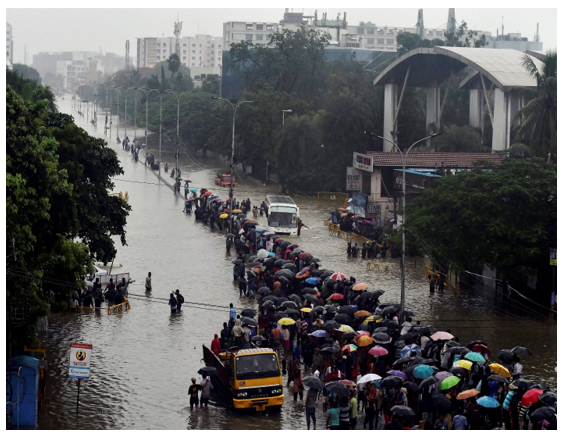- Courses
- GS Full Course 1 Year
- GS Full Course 2 Year
- GS Full Course 3 Year
- GS Full Course Till Selection
- MEP (Mains Enrichment Programme) Data, Facts
- Essay Target – 150+ Marks
- Online Program
- GS Recorded Course
- NCERT- First Ladder
- Polity
- Geography
- Economy
- Ancient, Medieval and Art & Culture AMAC
- Modern India, Post Independence & World History
- Environment
- Governance
- Science & Technology
- International Relations and Internal Security
- Disaster Management
- Ethics
- Current Affairs
- Indian Society and Social Issue
- CSAT
- 5 LAYERED ARJUNA Mentorship
- Public Administration Optional
- ABOUT US
- OUR TOPPERS
- TEST SERIES
- FREE STUDY MATERIAL
- VIDEOS
- CONTACT US
Rising Challenge of Urban Floods in India
Rising Challenge of Urban Floods in India
13-07-2023

Latest Context:
At present, India is witnessing heavy urban floods in many parts of the country.
What is Urban Flooding?
- Urban flooding refers to the excessive accumulation of water in urban areas, such as cities and towns, due to heavy rainfall or other factors.
- It occurs when the capacity of urban drainage systems, such as stormwater drains, sewers, and canals, is overwhelmed by the volume of water.
Factors contributing to Urban Flooding are:
- Hard Surfaces: Urban areas are characterized by extensive hard surfaces such as concrete, asphalt, and buildings. These surfaces prevent rainwater from infiltrating into the ground, leading to increased runoff and reduced natural drainage.
- Inadequate Drainage Infrastructure: Outdated or undersized drainage systems can be overwhelmed by heavy rainfall, leading to insufficient capacity to handle the volume of water. This can result in water accumulation and flooding.
- Rapid Urbanization: The expansion of urban areas and the conversion of natural land surfaces into built-up areas reduce the availability of open spaces for water absorption. As cities grow and development increases, the amounts of hard surfaces also rise, increasing the flooding risk.
- Poor Urban Planning: Inadequate urban planning practices can contribute to urban flooding. Inefficient placement of drainage systems, insufficient consideration of flood-prone areas, and inadequate zoning regulations can increase the vulnerability of urban areas to flooding.
- Climate Change: Climate change plays a significant role in urban flooding. It can lead to more frequent and intense rainfall events, exceeding the capacity of existing drainage systems. Rising sea levels also increase the risk of coastal cities experiencing flooding due to storm surges and high tides.
- Blocked or Inadequate Drainage Systems: Blockages in stormwater drains, sewers, and culverts due to debris, sediment, or solid waste can restrict the flow of water. Inadequate maintenance of drainage systems can also contribute to flooding problems.
- Lack of Green Infrastructure: The absence of green infrastructure, such as parks, green spaces, and natural waterways, reduces the ability of urban areas to absorb and store rainwater. Green infrastructure helps in managing stormwater runoff, reducing the risk of flooding.
- Human Activities: Improper waste disposal practices, such as dumping trash and debris into drainage systems, can block the flow of water and contribute to flooding. Alteration of natural waterways and wetlands, which act as natural flood buffers, can also increase flood risk.
Urban Flooding can have various consequences like:
- Infrastructure Damage: Floodwaters can damage roads, bridges, buildings, and other infrastructure components, leading to structural instability, foundation damage, and even collapse. This can disrupt transportation networks, hinder emergency response efforts, and result in costly repairs.
- Disruption of Services: Urban flooding can cause disruptions in essential services such as electricity, water supply, and communication networks which can lead to power outages, contaminated water supply, and limited access to emergency services.
- Property Damage and Loss: Flooding can result in extensive damage to residential and commercial properties. Water intrusion can destroy belongings, furniture, and equipment, leading to financial losses for individuals, businesses, and insurance companies.
- Public Health Risks: Floodwaters often carry contaminants, including pollutants, sewage, and hazardous substances, which can pose health risks to the public. Exposure to contaminated water can lead to waterborne diseases, respiratory issues, and other health problems. Additionally, stagnant water after flooding can become breeding grounds for mosquitoes and other disease vectors.
- Economic Impact: Urban flooding can have significant economic consequences for cities and communities. It can disrupt business operations, lead to job losses, and affect local economies. The costs associated with infrastructure repairs, property damage, and the recovery process can place a substantial financial burden on governments and individuals.
- Displacement of People: In severe cases, urban flooding can force people to evacuate their homes temporarily or permanently. Displaced individuals may require emergency shelter, leading to additional strain on resources and support systems. The displacement can also result in social and psychological challenges for affected communities.
- Environmental Damage: Urban flooding can cause environmental degradation. Floodwaters can wash away topsoil, erode riverbanks, and damage ecosystems. It can also lead to the release of pollutants into water bodies, impacting aquatic life and biodiversity.
- Long-Term Impacts: Urban flooding can have lasting effects on communities. It can lead to decreased property values, reduced investment opportunities, and a decline in the quality of life. Repeat flooding events can also result in increased insurance costs and difficulty obtaining coverage in flood-prone areas.
What are the ways to tackle Urban Flooding?
- Improve Drainage Infrastructure: Upgrading and expanding drainage systems, including stormwater drains and sewers can increase their capacity to handle larger volumes of water. Regular maintenance and cleaning of drainage systems are also crucial to prevent blockages and ensure proper functioning.
- Green Infrastructure: Implementing green infrastructure solutions can help manage stormwater effectively and reduce urban flooding. This includes techniques such as constructing rain gardens, bioswales, and permeable pavements that allow rainwater to infiltrate into the ground, reducing runoff.
- Sustainable Urban Planning: Incorporating flood mitigation measures into urban planning is essential. This involves avoiding construction in flood-prone areas, setting aside open spaces for water absorption and retention, and implementing zoning regulations that consider flood risk. Smart growth principles, such as compact development and preserving natural drainage patterns, can also help reduce flooding impacts.
- Retention and Detention Basins: Constructing retention and detention basins in strategic locations can temporarily store excess water during heavy rainfall, reducing the strain on drainage systems. These basins release water gradually, minimizing the risk of flooding downstream.
- Floodplain Management: Implementing effective floodplain management strategies can help regulate development in flood-prone areas. This may involve enforcing building codes and regulations that consider flood risk, restricting construction in high-risk zones, and promoting flood-resistant building designs.
- Sustainable Stormwater Management: Employing sustainable stormwater management practices can reduce runoff and minimize the risk of flooding. Techniques such as rainwater harvesting, decentralized storage systems, and green roofs can help capture and reuse rainwater, reducing the load on drainage systems.
- Flood Warning Systems: Installing early warning systems can provide timely information about impending flood events, allowing residents and authorities to take necessary precautions. These systems typically include monitoring rainfall, water levels in rivers and drains, and issuing alerts to inform people in at-risk areas.
- Public Awareness and Education: Educating the public about flood risks, preparedness measures, and proper waste disposal practices can contribute to reducing urban flooding. Promoting awareness campaigns, conducting community workshops, and providing information on emergency response procedures can help individuals and communities be better prepared for flooding events.
- International Cooperation and Knowledge Sharing: Collaboration among cities, regions, and countries facing similar challenges can facilitate the exchange of best practices, lessons learned, and innovative solutions. Sharing knowledge and experiences can enhance flood management strategies and improve resilience to urban flooding.
Conclusion:
It is important to implement a combination of these strategies as per the specific needs and conditions of each urban area. Integrated and holistic approaches that combine engineering solutions with sustainable urban development principles are key to effectively tackle urban flooding.
Must Check: IAS Coaching Centre In Delhi



